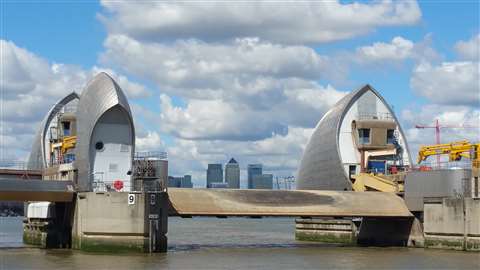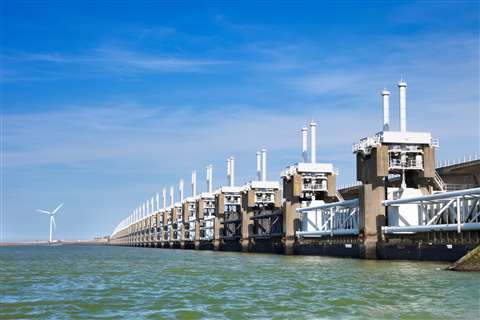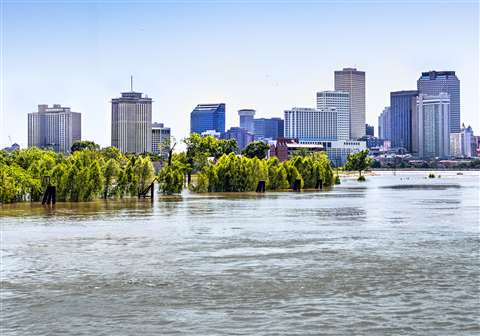How construction can combat the growing risk of flooding
31 May 2023
Climate change means that bigger and more sophisticated flood alleviation projects are becoming crucial to protect communities across the globe.
Adam Hosking, vice president and global director for water resources and resilience at technical consultancy Jacobs, explains the scale of the challenge, the innovative solutions that the construction industry can provide, which countries are leading the way and why future projects will require greater funding.
 The Thames Barrier in London, UK (Image: Jacobs)
The Thames Barrier in London, UK (Image: Jacobs)
What is the scale of flood alleviation challenge globally given that climate change is exacerbating extreme weather events?
The scale of flood alleviation challenge is huge, as climate change is not only affecting more intense rainfall, but also sea level rise.
There is an increasing recognition globally that flooding can happen just about anywhere. In the U.S. the Federal Emergency Management Agency (FEMA) uses the phrase ‘anywhere it rains, it can flood’ in their outreach, and this is truer now than ever. This is due to both climate change increasing rainfall frequency and intensities, but also the effect of development in communities creating more impervious areas that increase the speed and volume of runoff.
Recently, I was in Fort Lauderdale, Florida when an incredible 26 inches of rain fell in a single day (mainly a short period in the afternoon). This ‘rain bomb’, caused widespread flooding and disruption completely overwhelming drainage systems designed for orders of magnitude smaller events.
These extreme events are becoming more frequent and are inevitably driving growth in the global market for flood alleviation solutions.
However, the opportunity is not limited to addressing climate change, but also changing how we manage our water environment at a catchment level. Water quality as opposed to quantity is now beginning to be prioritised.
Floods are one of the most destructive natural hazards, and flood frequency is predicted to increase across 42% of the land on Earth by the end of the century, costing over $40 billion in extensive damage, and causing untold stress, loss of life and disruption worldwide.
Is the level of investment that Jacobs is seeing at national levels sufficient to meet the challenges?
 Adam Hosking (Image supplied by Jacobs)
Adam Hosking (Image supplied by Jacobs)
No, the level of investment is significantly lower than what is needed given the scale of the challenge is growing rapidly and we continue to see flood events occurring globally.
Having said that, we are seeing governments prioritising and expanding their investments in this space in recognition of the growing challenge.
In England, for example, we have seen a commitment from government for a significant increase in investment over the current funding cycle, allocating £5.2 billion (US$6.5 billion) over the six years 2021-2027. This is alongside a comprehensive national flood strategy that delivers not just new protection infrastructure, but a wider holistic approach to flood risk management and resilience. Despite this funding, the UK model requires ‘partnership funding’ for many projects to advance, and this can present a significant challenge to progressing solutions, particularly now with the financial challenges facing all sectors.
In the US, the recent Infrastructure, Investment and Jobs Act (IIJA) and Inflation Reduction Act (IRA) have both committed significant sums to climate action and resilience including urban, fluvial and coastal flood risk management programmes.
In Singapore, the national government has committed to coastal flood protection to address sea level rise risks as a national priority. Recognising this will cost tens of billions of dollars over the long term, the government has established a dedicated coastal protection department and embarked on a comprehensive strategy to guide the delivery of long-term resilience.
The Netherlands was always seen as a centre of excellence for water engineering, is that still the case?
Given the nature of the existential threat that flooding poses to the Netherlands, the country has made a national priority out of the development and funding of coastal protection engineering to provide a high level of reliability in the prevention of flooding risks. Consequently, the ‘Delta works’ system is an incredible engineered system, with storm surge barriers, dunes, embankments and a complex internal drainage system to manage stormwater impacts.
There are other locations globally that have excellent engineered systems, necessary to manage the significant flood risks they face. The ‘Hurricane Storm Damage Risk Reduction System’ (HSDRRS) of New Orleans, USA, that has been implemented following the devastation of Hurricane Katrina (2005) is world leading. The engineered system now provides the city with a high level of protection.
What is perhaps most impressive about the New Orleans system is the speed at which it was designed and constructed in the wake of the storm. For example, the billion-dollar West Closure Complex Gate and pump station system was operational by August 2021, just seven years after the storm. Typically, this would take decades!
Singapore’s programme is becoming world-class as they learn from best practices globally, implement them into their own programme and invest to develop further innovation.
 Eastern Scheldt storm barrier in Zeeland, The Netherlands (Image: Sarah_winter via AdobeStock - stock.adobe.com)
Eastern Scheldt storm barrier in Zeeland, The Netherlands (Image: Sarah_winter via AdobeStock - stock.adobe.com)
In terms of the evolving approach to flood risk management and the need for a nuanced approach combining hard structures, catchment approaches, nature-based solutions and non-structural approaches, I consider the strategic, risk-based approach developed and applied in England, led by the Environment Agency, to be very sophisticated and world-leading. In part necessitated by the need to prioritise funding allocations, the risk-based approach drives a strong understanding of risk, both today and how that is likely to change into the future, considering the full range of potential solutions, engaging stakeholders, and developing the most appropriate solution for the risk and context. This differs from the Netherlands and New Orleans (for example) where large-engineered solutions are really the only option (albeit this can be in tandem with nature-based and other approaches).
Another great example of UK leadership is the Thames Estuary Asset Management 2100 (TEAM2100) programme, which is delivering the first ten years of tidal flood risk reduction under the TE2100 Strategy. This integrated delivery programme is the first of its kind in the world, looking to optimise the maintenance and incremental improvement of the highly complex system of barriers, gates, pumps, walls and embankments that protect London from flooding, following an adaptive pathway approach to monitor and adjust to deliver both cost efficiencies and delivery improvements against traditional models. Supporting the focus towards net-zero carbon, designers and construction teams work together to drive down whole life carbon demand on individual projects. Using established carbon planning tools and working collaboratively to transform the way these are applied the programme has integrated carbon accounting throughout the project lifecycle.
Countries leading the way in the stormwater field include parts of the USA, Australia, New Zealand and Germany. There are others with a focus on water resource management as well as flood risk reduction, including Singapore, the Netherlands and Denmark.
Traditionally, schemes have been designed using computer models against benchmarks such as ‘1 in 100-year floods’. Given climate change, is the engineering profession adjusting its models or design standards?
Adaptive management, and particularly adaptation pathways, are now a widely recognised and used approach to managing the deep uncertainty arising from future climate change.
This approach recognises that we cannot predict exactly what flood/sea levels may be at a particular point in the future, but we do know the overall direction/trend of change. We can therefore design and implement our solutions in a way to stay ahead of changes, managing risk down to tolerable levels, and actively monitoring to ensure our next resilience actions are planned and delivered in time to maintain that tolerable level of risk.
 National park Oosterschelde, Delta Works, Netherlands (Image: Andrea Aigner via AdobeStock - stock.adobe.com)
National park Oosterschelde, Delta Works, Netherlands (Image: Andrea Aigner via AdobeStock - stock.adobe.com)
This approach can include approaches such as designing flood protection structures in a way that enables them to be added to in the future, if necessary, as the climate changes. It also enables us to identify and progress “no regrets” actions/designs, being those actions that we know deliver their intended outcome/performance regardless of future climate scenario. These can include actions that reduce flood levels (catchment actions such as upstream flow abatement), remove vulnerable assets from risk areas.
The adoption of adaptive approaches is definitely a change from the ‘traditional’ approach of design and build to a fixed level that is expected to be suitable through the entire life of the asset. This change is requiring regulators and agencies to evolve how they promote and permit flood risk management activities, as it requires greater flexibility in approach and outcome than is typically accepted.
We have to be more flexible in our planning, delivery and funding if we are to avoid unsustainable solutions to the uncertainties of climate change.
Do you see a move away from traditional ‘heavy engineering’ solutions towards ‘soft’ engineering such as the use of natural wetlands?
With the increase in hazards due to climate change, there will definitely remain a need for hard engineered structures to provide certainty of protection to the communities, infrastructure and other assets that are necessary to protect in place.
However, in the face of these growing hazards, we need to look to the full spectrum of solutions available to us to most effectively manage risk and deliver multiple social, economic and environmental objectives. These include contributing towards net zero carbon, biodiversity enhancement, environmental net gain. This will inevitably include a growing use of nature-based solutions that can both work as stand-alone solutions to reduce flooding hazards, while delivering wider environmental and social benefits, as well as operating in tandem with hard structures, for ‘hybrid’ solutions, that offer enhanced outcomes.
 Flooded Mississippi with New Orleans skyline (Image: Don via AdobeStock - stock.adobe.com)
Flooded Mississippi with New Orleans skyline (Image: Don via AdobeStock - stock.adobe.com)
The growing risks also require the use of non-structural approaches, including floodproofing of assets where a flooding risk remains, and relocation where important infrastructure or buildings remain at an unacceptable level of risk and protecting in situ is not viable.
Our recent work at Tyndall Air Force Base in Florida USA, is a great example of the integrated, adaptive approach to addressing long-term coastal flooding risks. Here our Coastal Resilience Implementation Plan (CRIP), has set out a prioritised strategy that includes ‘traditional’ structures such as walls and levees to protect more vulnerable critical assets, nature-based solutions including wetlands, dunes and living breakwaters to reduce hazards and provide habitat benefits, phased elevation of some assets as risks increase into the future, and a risk informed approach to future development and activities.
When we consider inland, fluvial (river) and pluvial (stormwater) flooding, this holistic approach is driving a greater focus on catchment scale approaches, whereby we look to work with natural hydrology and slow/capture the flow of water before it gets to areas of flood risk. These include a variety of approaches, such as green stormwater infrastructure in our urban areas, and flow abatement solutions in rivers/streams.
As we progress with the implementation of these catchment solutions, they will inevitably lessen our dependence on hard structures at the point of flooding.
What progress is being made in the development of computer modelling of rivers and historic flood events?
The UK is a global leader in the development of the flood modelling technology.
For more than 40 years we have been using computer models for assessing flood risk and designing flood management solutions, and for almost 20 years for flood forecasting. For example, Flood Modeller underpins the national flood forecasting systems of England, Scotland and Wales. It has been used to design most of the flood risk management schemes built by the Environment Agency over the last 25 years.
Key areas of progress in the modelling application include the ability to model the river, drainage and surface water in high resolution. This is down to a combination of better data and improvements to the modelling applications to make them practicable to do.
What new technology (drones, mapping systems, AI) is proving most useful in this area?
We are starting to see rapid changes in what is possible with the modelling.
For example, complex flood simulations that previously took hours or maybe days to undertake can now be done in minutes thanks to GPU cards and cloud computing (they are not only used to mine Bit Coins or run the Metaverse), and automation processes are helping streamline many modelling tasks.
We are starting to see machine learning improve the accuracy and reduce the uncertainty in analysis and drive optimal design solutions.
In the future, we can expect to see AI playing a role along with new methods for real time data acquisition. For example, a new generation of satellites will collect high resolution rainfall data, across the globe, to drive weather prediction models; drones can be used to gather highly detailed terrain data used to build the flood models or provide detailed flood event data to help validate models.



